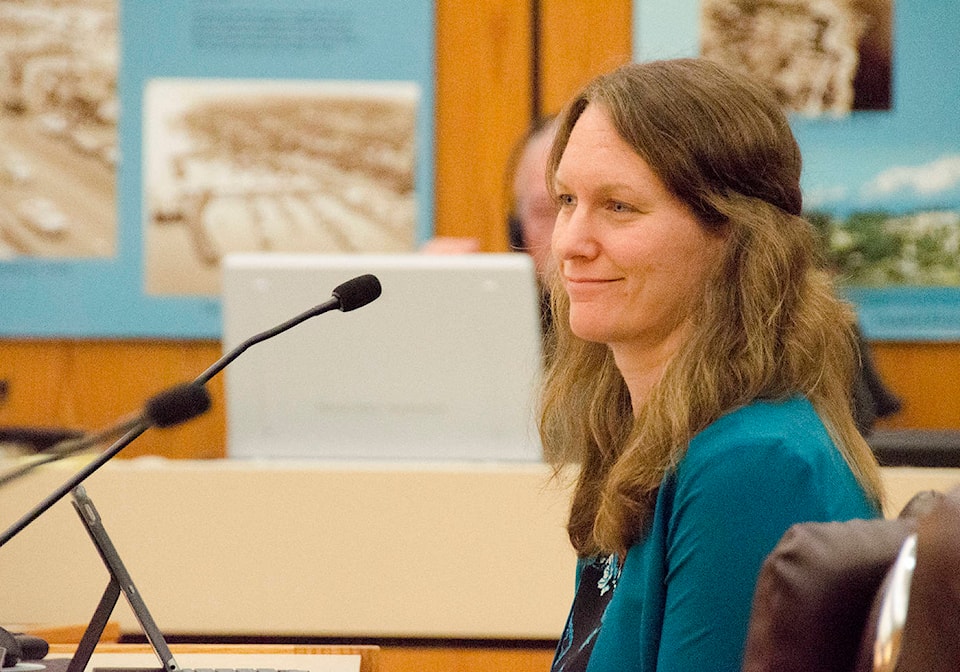Campbell River city council passed its latest round of zoning bylaw amendments this week, but not before some discussion about what the next round of changes to the document should entail – spurred by the discussion at the public hearing three weeks ago surrounding developers in town blocking views and skirting the rules around height restrictions.
While city council was discussing the legal changes to the wording in its zoning bylaws at the public meeting surrounding the amendment at the end of August, some members of the public – everyone who spoke, in fact – took the opportunity to raise their frustrations over contractors exploiting loopholes in the building height restrictions – and encouraging council to increase the repercussions for not following them.
“The amendment in regards to building height is only to clarify the definition in terms of where building height is measured from and the definition of ‘original subdivision grade,’” said senior planner Chris Osborne while introducing the amendments being proposed. “The intent isn’t to change what the zoning bylaw says about height or the height limits it prescribes in the different zones,” although he did add, “that is certainly something that may follow on later, but at the present time, the amendment is limited to clarity.”
RELATED: Public hearing set for latest round of zoning bylaw changes
But Donna and Daniel Lamarche said they would very much like to see the height limits adjusted, as well, or at least have more accountability for those who attempt to skirt the rules. They told council that the lot being built on across the street from their home was built up with fill to raise the base level from which to measure its height, which they feel is unfair.
“We’ve been told by many city officials that they were unaware that the grade of the property had changed,” Daniel said. “Well it did, and the neighbours can attest to that. This practice has been ongoing. Contractors are changing the average grade of a property and are getting away with it. This has happened again and again and you know it.”
The Lamarches want council to set different priorities when it comes to these types of development, at least in already-established neighbourhoods.
“Something has to be done. The people who have lived in these communities for decades are the ones who have built this community, and now somebody can come in and build a box monster box. It might be legal, but it doesn’t make it right.”
Others presented similar situations to council that night.
Val Taylor said she also has a house going up in front of her view that is being built on land that was raised before construction began, and Brenda Loerke said while her situation isn’t as bad, she feels for some of her neighbours, “who have had their views totally obliterated by what was referred to as an ancillary building,” which was also built on raised land.
“Clearly this has been going on over and over and over again,” Loerke says. “I’m gobsmacked that we are still here and I’m seeing new construction go up continuing to do the same thing. You people have clearly heard about land being raised up, and I do hope that whatever this bylaw is … will change what’s going on out there right now.”
Osborne said that although the particular amendments being discussed wouldn’t fix all of the height concerns, the wording changes proposed, “were in part designed to stop people from ‘fudging the grade,’ as it were.” And, in fact, by the time the “legal clarifications” amendment was passed this week, there had been more wording added to help the city address at least that particular facet of the issue.
“You may note in the council report that we have included some additional wording based on feedback received at the public meeting,” said long-range planning and sustainability manager Amber Zirnhelt this week.
“We’ve included geological or visual records as part of the review of ‘original average grade,’ and we’ve also, under ‘original grade’ added, ‘before the addition of topsoil or other fill,’ to provide further clarity and address some of these concerns.”
Zirnhelt also confirmed that, in response to the feedback at the public hearing, council should expect more changes surrounding building height to be brought forward in a subsequent amendment recommendation.
“One of the things staff identified post-public-hearing is the need to bring back, as part of our subsequent zoning bylaw review, a further review of building height and how we interpret it in our community,” Zirnhelt said. “Right now we’re just looking at the definitions, but we see a bigger issue – as you heard from the community – regarding building height that will be part of a broader discussion in the future.”
